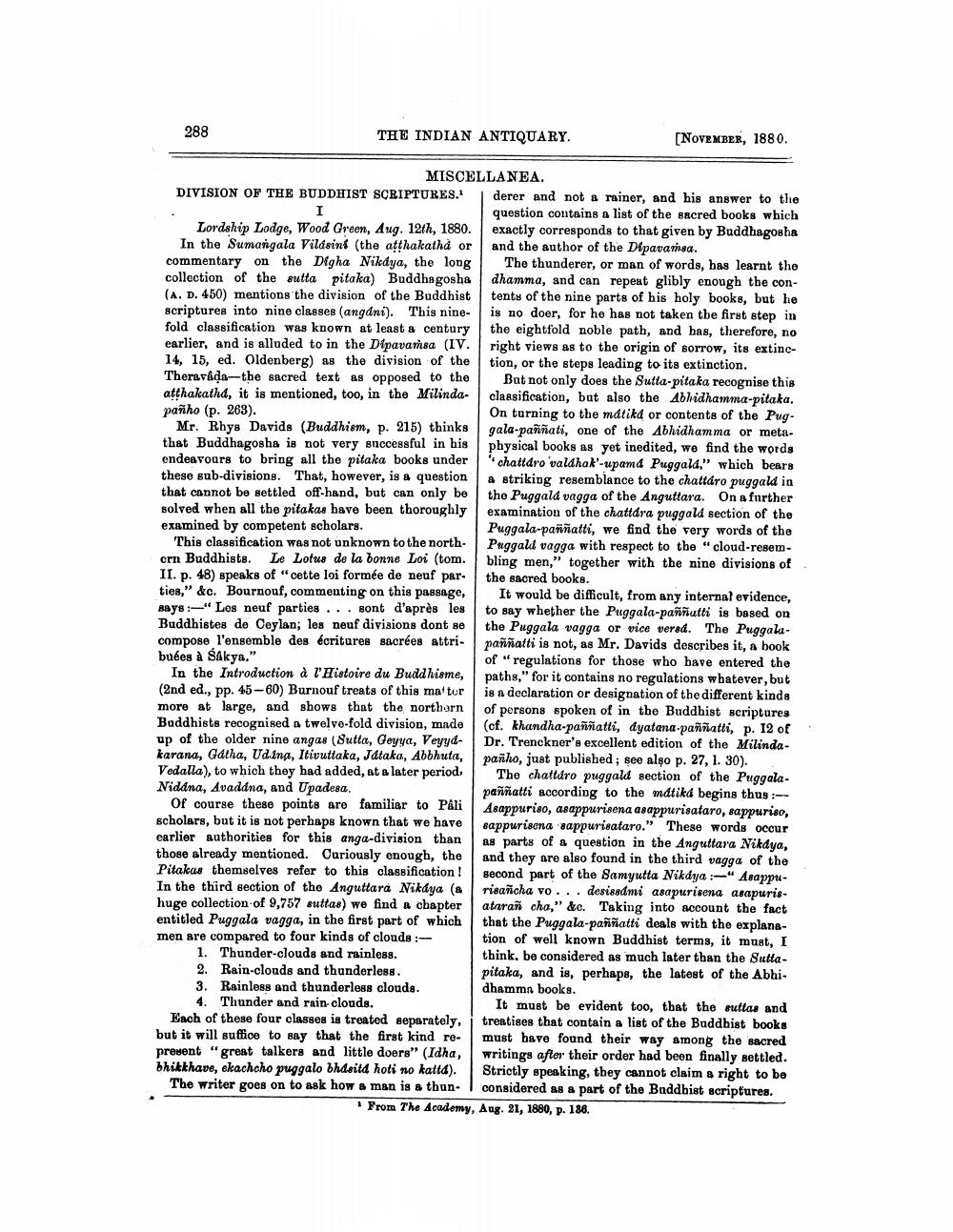________________
288
THE INDIAN ANTIQUARY.
MISCELLANEA.
DIVISION OF THE BUDDHIST SCRIPTURES. I
Lordship Lodge, Wood Green, Aug. 12th, 1880. In the Sumangala Vilásins (the aṭṭhakatha or commentary on the Digha Nikaya, the long collection of the sutta pitaka) Buddhagosha (A. D. 450) mentions the division of the Buddhist scriptures into nine classes (angdni). This ninefold classification was known at least a century earlier, and is alluded to in the Dipavamsa (IV. 14, 15, ed. Oldenberg) as the division of the Theravada-the sacred text as opposed to the atthakatha, it is mentioned, too, in the Milindapañho (p. 263).
Mr. Rhys Davids (Buddhism, p. 215) thinks that Buddhagosha is not very successful in his endeavours to bring all the pitaka books under these sub-divisions. That, however, is a question that cannot be settled off-hand, but can only be solved when all the pitakas have been thoroughly examined by competent scholars.
This classification was not unknown to the northcrn Buddhists. Le Lotus de la bonne Loi (tom. II. p. 48) speaks of "cette loi formée de neuf parties," &c. Bournouf, commenting on this passage, Bays" Les neuf parties... sont d'après les Buddhistes de Ceylan; les neuf divisions dont se compose l'ensemble des écritures sacrées attribuées à Śâkya."
In the Introduction à l'Histoire du Buddhisme, (2nd ed., pp. 45-60) Burnouf treats of this matter more at large, and shows that the northern Buddhists recognised a twelve-fold division, made up of the older nine angas (Sutta, Geyya, Veyydkarana, Gátha, Udina, Itivuttaka, Játaka, Abbhuta, Vedalla), to which they had added, at a later period, Nidána, Avadána, and Upadesa.
Of course these points are familiar to Páli scholars, but it is not perhaps known that we have earlier authorities for this anga-division than those already mentioned. Curiously enough, the Pitakus themselves refer to this classification! In the third section of the Anguttara Nikaya (a huge collection of 9,757 suttas) we find a chapter entitled Puggala vagga, in the first part of which men are compared to four kinds of clouds :
1. Thunder-clouds and rainless.
2. Rain-clouds and thunderless.
3. Rainless and thunderless clouds. 4. Thunder and rain clouds.
Each of these four classes is treated separately, but it will suffice to say that the first kind represent "great talkers and little doers" (Idha, bhikkhave, ekachcho puggalo bhdsitá hoti no kattá).
The writer goes on to ask how a man is a thun
[NOVEMBER, 1880.
derer and not a rainer, and his answer to the question contains a list of the sacred books which exactly corresponds to that given by Buddhagosha and the author of the Dipavamsa.
The thunderer, or man of words, has learnt the dhamma, and can repeat glibly enough the contents of the nine parts of his holy books, but he is no doer, for he has not taken the first step in the eightfold noble path, and has, therefore, no right views as to the origin of sorrow, its extinction, or the steps leading to its extinction.
But not only does the Sutta-pitaka recognise this classification, but also the Abhidhamma-pitaka. On turning to the mátikd or contents of the Puggala-paññati, one of the Abhidhamma or metaphysical books as yet inedited, we find the words "chattaro valdhak'-upama Puggala," which bears a striking resemblance to the chattáro puggald in the Puggala vagga of the Anguttara. On a further examination of the chattára puggald section of the Puggala-paññatti, we find the very words of the Puggali vagga with respect to the "cloud-resembling men," together with the nine divisions of the sacred books.
It would be difficult, from any internal evidence, to say whether the Puggala-paññutti is based on the Puggala vagga or vice versa. The Puggalapaññatti is not, as Mr. Davids describes it, a book of "regulations for those who have entered the paths," for it contains no regulations whatever, but is a declaration or designation of the different kinds of persons spoken of in the Buddhist scriptures (cf. khandha-paññatti, dyatana-paññatti, p. 12 of Dr. Trenckner's excellent edition of the Milindapañho, just published; see also p. 27, 1. 30).
The chattaro puggald section of the Puggalapaññatti according to the mátiká begins thus:-- Asappuriso, asappurisena asappurisataro, sappuriso, sappurisena sappurisataro." These words occur as parts of a question in the Anguttara Nikdya, and they are also found in the third vagga of the second part of the Samyutta Nikdya :-" Asappurisañcha vo... desisedmi asapurisena asapurisatarañ cha," &c. Taking into account the fact that the Puggala-paññatti deals with the explanation of well known Buddhist terms, it must, I think. be considered as much later than the Suttapitaka, and is, perhaps, the latest of the Abhidhamma books.
It must be evident too, that the suttas and treatises that contain a list of the Buddhist books must have found their way among the sacred writings after their order had been finally settled. Strictly speaking, they cannot claim a right to be considered as a part of the Buddhist scriptures.
1 From The Academy, Aug. 21, 1880, p. 136.




